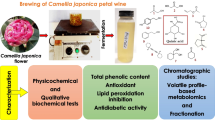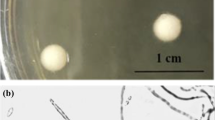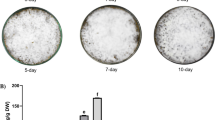Abstract
The pure culture fermentation has led to less flavorful rice wine and relatively lower bioactive substance level compared to traditional mixed culture fermentation; however, a pure strain is easily controlled by industrialized producers. The purpose of the present research was to screen a species of Rhizopus for improving the flavor deficiency and antioxidant function of sweet rice wine. Seven rice wine samples fermented with isolated strains were analyzed for their total phenolics, total flavonoids, peptide and antioxidant activity using spectrophotometry, as well as ethanol, ethyl acetate, β-phenethyl alcohol, and volatile alcohol contents measured by headspace gas chromatography (HS-GC), the further principal component analysis determined Rhizopus delemar rice wine better on aroma and antioxidant capacity. A comparison of phenolics profile between R. delemar and R. oryzae rice wines was made based on the measurement data of ultrahigh-performance liquid chromatography coupled with Q-exactive orbitrap mass spectrometry (UHPLC-QE-MS) data. Thirty-two phenolics were identified in sweet rice wine. Overall, the results presented in this study showed that a strain of R. delemar is available for the improvement of flavor and antioxidant activity in sweet rice wine, which has the great potential to be applied to industrialized products.





Similar content being viewed by others
Availability of data and material
The datasets used or analyzed during the current study are available from the corresponding author on reasonable request.
Abbreviations
- BLAST:
-
The basic local alignment search tool
- CA:
-
Cluster analysis
- FRAP:
-
Ferric reducing antioxidant power
- GAE:
-
Gallic acid equivalents
- GSH:
-
Glutathione
- GSHEAC:
-
Glutathione equivalent antioxidant capacity
- HS-GC:
-
Headspace-gas chromatography
- ITS:
-
Internally transcribed spacer
- MEGA:
-
Molecular evolutionary genetics analysis
- PDA:
-
Potato dextrose agar (medium)
- PCA:
-
Principal component analysis
- RE:
-
Rutin equivalent
- TCA:
-
Trichloroacetic acid
- TEAC:
-
Trolox equivalent antioxidant capacity
- TFC:
-
Total flavonoid content
- TPC:
-
Total phenolic content
- UHPLC-QE-MS:
-
Ultrahigh-performance liquid chromatography coupled with Q-exactive orbitrap mass spectrometer
- YRR1:
-
Isolated strain from the starter of Sichuan province, China
- YRR2:
-
Isolated strain from the starter of Hunan province, China
- YRR3:
-
Isolated strain from the starter of Guangxi province, China
- YRR4:
-
Isolated strain from the starter of Chongqing province, China
- YRR5:
-
Isolated strain from the starter of Guangxi province, China
- WJ01:
-
Rhizopus oryzae WJ01 (GenBank accession MT835118)
- AQR:
-
Commercial Rhizopus oryzae, Angel Yeast Co., Ltd, China
References
Adebo OA, Gabriela Medina-Meza I (2020) Impact of fermentation on the phenolic compounds and antioxidant activity of whole cereal grains: a mini review. Molecules 25(4):927. https://doi.org/10.3390/molecules25040927
Ambigaipalan P, Oh WY, Shahidi F (2020) Epigallocatechin (EGC) esters as potential sources of antioxidants. Food Chem 309:125609. https://doi.org/10.1016/j.foodchem.2019.125609
Cai H, Zhang Q, Shen L, Luo J, Zhu R, Mao J, Zhao M, Cai C (2019) Phenolic profile and antioxidant activity of Chinese rice wine fermented with different rice materials and starters. LWT-Food Sci Technol 111:226–234. https://doi.org/10.1016/j.lwt.2019.05.003
Chen L, Hui Y, Gao T, Shu G, Chen H (2021) Function and characterization of novel antioxidant peptides by fermentation with a wild Lactobacillus plantarum 60. LWT-Food Sci Technol 135:110162. https://doi.org/10.1016/j.lwt.2020.110162
De Beer D, Joubert E, Gelderblom WCA, Manley M (2003) Antioxidant activity of South African red and white cultivar wines: free radical scavenging. J Agric Food Chem 51(4):902–909. https://doi.org/10.1021/jf026011o
Godlewska-Żyłkiewicz B, Świsłocka R, Kalinowska M, Golonko A, Świderski G, Arciszewska Ż, Nalewajko-Sieliwoniuk E, Naumowicz M, Lewandowski W (2020) Biologically active compounds of plants: structure-related antioxidant, microbiological and cytotoxic activity of selected carboxylic acids. Materials 13(19):4454. https://doi.org/10.3390/ma13194454
Goufo P, Trindade H (2014) Rice antioxidants: phenolic acids, flavonoids, anthocyanins, proanthocyanidins, tocopherols, tocotrienols, γ-oryzanol, and phytic acid. Food Sci Nutr 2(2):75–104. https://doi.org/10.1002/fsn3.86
Hrebień-Filisińska A (2021) Application of natural antioxidants in the oxidative stabilization of fish oils: a mini-review. J Food Process Preserv 00:e15342. https://doi.org/10.1111/jfpp.15342
Jeong JW, Nam PW, Lee SJ, Lee KG (2011) Antioxidant activities of Korean rice wine concentrates. J Agric Food Chem 59(13):7039–7044. https://doi.org/10.1021/jf200901j
Jin Z, Cai G, Wu C, Hu Z, Xu X, Xie G, Wu D, Lu J (2021) Profiling the key metabolites produced during the modern brewing process of Chinese rice wine. Food Res Int 139:109955. https://doi.org/10.1016/j.foodres.2020.109955
Jun SH, Kim NH, Shim MB, Jeon YW, Ahn JH, Lee SH, Hwang IG, Rhee MS (2015) Microbiological diversity and prevalence of spoilage and pathogenic bacteria in commercial fermented alcoholic beverages (beer, fruit wine, refined rice wine, and yakju). J Food Prot 78(4):812–818. https://doi.org/10.4315/0362-028X.JFP-14-431
Kang HR, Hwang HJ, Lee JE, Kim HR (2016) Quantitative analysis of volatile flavor components in Korean alcoholic beverage and Japanese sake using SPME-GC/MS. Food Sci Biotechnol 25(4):979–985. https://doi.org/10.1007/s10068-016-0159-7
Keot J, Bora SS, Das Kangabam R, Barooah M (2020) Assessment of microbial quality and health risks associated with traditional rice wine starter Xaj-pitha of Assam, India: a step towards defined and controlled fermentation. 3 Biotech. 10 (2) 64. https://doi.org/10.1007/s13205-020-2059-z
Kim SA, Kim NH, Lee SH, Hwang IG, Rhee MS (2014) Survival of foodborne pathogenic bacteria (Bacillus cereus, Escherichia coli O157:H7, Salmonella enterica Serovar Typhimurium, Staphylococcus aureus, and Listeria monocytogenes) and Bacillus cereus spores in fermented alcoholic beverages (beer and refined rice wine). J Food Prot 77(3):419–426. https://doi.org/10.4315/0362-028X.JFP-13-234
Kourouma V, Mu TH, Zhang M, Sun HN (2020) Comparative study on chemical composition, polyphenols, flavonoids, carotenoids and antioxidant activities of various cultivars of sweet potato. Int J Food Sci Technol 55(1):369–378. https://doi.org/10.1111/ijfs.14336
Kumar S, Stecher G, Li M, Knyaz C, Tamura K (2018) MEGA X: molecular evolutionary genetics analysis across computing platforms. Mol Biol Evol 35(6):1547–1549. https://doi.org/10.1093/molbev/msy096
Leal C, Santos RA, Pinto R, Queiroz M, Rodrigues M, José Saavedra M, Barros A, Gouvinhas I (2020) Recovery of bioactive compounds from white grape (Vitis vinifera L.) stems as potential antimicrobial agents for human health. Saudi J Biol Sci 27(4):1009–1015. https://doi.org/10.1016/j.sjbs.2020.02.013
Lin H, Zhang J, Ni T, Lin N, Meng L, Gao F, Luo H, Liu X, Chi J, Guo H (2019) Yellow wine polyphenolic compounds prevents doxorubicin-induced cardiotoxicity through activation of the Nrf2 signaling pathway. J Cell Mol Med 23(9):6034–6047. https://doi.org/10.1111/jcmm.14466
Londoño-Hernández L, Ramírez-Toro C, Ruiz HA, Ascacio-Valdés JA, Aguilar-Gonzalez MA, Rodríguez-Herrera R, Aguilar CN (2017) Rhizopus oryzae - ancient microbial resource with importance in modern food industry. Int J Food Microbiol 257:110–127. https://doi.org/10.1016/j.ijfoodmicro.2017.06.012
Lu QY, Lee RP, Huang J, Yang J, Henning SM, Hong X, Heber D, Li Z (2015) Quantification of bioactive constituents and antioxidant activity of Chinese yellow wine. J Food Composit Anal 44:86–92. https://doi.org/10.1016/j.jfca.2015.07.005
Lu C, Mao S, Tong H, Ding Y (2018) Progress in the synthesis of catechin and its derivatives. Food Sci 39(11):316–326. https://doi.org/10.7506/spkx1002-6630-201811048(inChinese)
Luo H, Zeng L, Zhang Y, Chen Y, Li H, Bai W, Liu X (2021) Research progress of peptides in Huangjiu. Morden Food 02:85–88. https://doi.org/10.16736/j.cnki.cn41-1434/ts.2021.02.025(inChinese)
Peng L, Ai-lati A, Ji Z, Chen S, Mao J (2019) Polyphenols extracted from Huangjiu have anti-inflammatory activity in lipopolysaccharide stimulated RAW264.7 cells. RSC Adv 9(10):5295–5301. https://doi.org/10.1039/c8ra09671f
Şanlier N, Gökcen BB, Sezgin AC (2019) Health benefits of fermented foods. Crit Rev Food Sci Nutr 59(3):506–527. https://doi.org/10.1080/10408398.2017.1383355
Song JH, Kim JH, Ahn BH, Lee JS (2010) Screening of functional Rhizopus stolonifer for alcohol fermentation and production of high quality Korean traditional rice wine. Mycobiol 38(2):122–127. https://doi.org/10.4489/MYCO.2010.38.2.122
Wojdyło A, Samoticha J, Chmielewska J (2021) Effect of different pre-treatment maceration techniques on the content of phenolic compounds and color of Dornfelder wines elaborated in cold climate. Food Chem 339:127888. https://doi.org/10.1016/j.foodchem.2020.127888
Wu Z, Xu E, Long J, Pan X, Xu X, Jin Z, Jiao A (2016) Comparison between ATR-IR, Raman, concatenated ATR-IR and Raman spectroscopy for the determination of total antioxidant capacity and total phenolic content of Chinese rice wine. Food Chem 194:671–679. https://doi.org/10.1016/j.foodchem.2015.08.071
Xiang W, Xu Q, Zhang N, Rao Y, Zhu L, Zhang Q (2019) Mucor indicus and Rhizopus oryzae co-culture to improve the flavor of Chinese turbid rice wine. J Sci Food Agric 99(12):5577–5585. https://doi.org/10.1002/jsfa.9831
Xu Y, Dai T, Li T, Huang K, Li Y, Liu C, Chen J (2019) Investigation on the binding interaction between rice glutelin and epigallocatechin-3-gallate using spectroscopic and molecular docking simulation. Spectrochim Acta A Mol Biomol Spectrosc 217:215–222. https://doi.org/10.1016/j.saa.2019.03.091
Yu H, Xie T, Xie J, Ai L, Tian H (2019) Characterization of key aroma compounds in Chinese rice wine using gas chromatography-mass spectrometry and gas chromatography-olfactometry. Food Chem 293:8–14. https://doi.org/10.1016/j.foodchem.2019.03.071
Acknowledgements
This study was supported by Hunan Provincial Science and Technology Department, China (Grant No. 2020SK2140) and the Technology Development Project of Jiangxi Lidu Liquor Industry Co. Ltd. (No. 2019430102003061 and No. 2020430102002535). The authors wish to acknowledge Professor Xiyun Deng, University of Hunan Normal University, for his help in providing language help. Thanks to Mr. Shengang Liu for providing information help.
Funding
This study was supported by Hunan Provincial Science and Technology Department, China (Grant No. 2020SK2140) and the Technology Development Project of Jiangxi Lidu Liquor Industry Co. Ltd. (No. 2019430102003061 and No. 2020430102002535).
Author information
Authors and Affiliations
Contributions
Conceptualization, Y.Y. and T.Y.; Methodology, Y.Y.; Formal Analysis, Y.Y.; Investigation, Y.Y., N.Y. and S.X.; Resources, T.Y.; Data Curation, Y.Y.; Writing – Original Draft Preparation, Y.Y.; Writing – Review & Editing, H.Z. and T.Y.; Visualization, Y.Y. and N.Y.; Supervision, T.Y. and H.Z.
Corresponding author
Ethics declarations
Conflict of interest
The authors declare that they have no known competing financial interests or personal relationships that could have appeared to influence the work reported in this paper.
Ethics approval
This article does not contain any studies with human or animal subjects.
Additional information
Publisher's Note
Springer Nature remains neutral with regard to jurisdictional claims in published maps and institutional affiliations.
Supplementary Information
Below is the link to the electronic supplementary material.
Rights and permissions
About this article
Cite this article
Yang, Y., Zhong, H., Yang, N. et al. Quality improvement of sweet rice wine fermented with Rhizopus delemar on key aroma compounds content, phenolic composition, and antioxidant capacity compared to Rhizopus oryzae. J Food Sci Technol 59, 2339–2350 (2022). https://doi.org/10.1007/s13197-021-05250-x
Revised:
Accepted:
Published:
Issue Date:
DOI: https://doi.org/10.1007/s13197-021-05250-x




